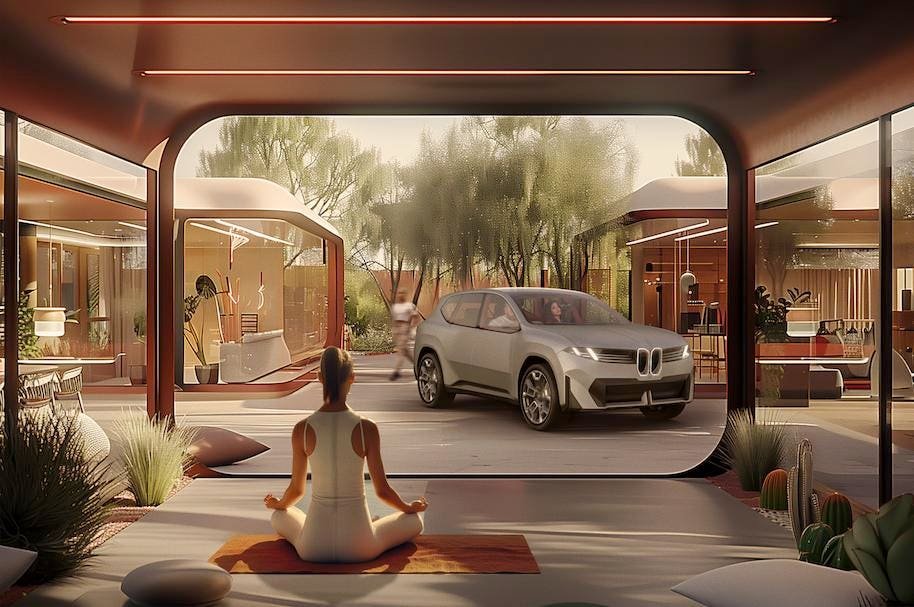Architecture firms Gensler and Designworks USA release renderings of the EV charging stations of the future … [+]
When drivers are looking for a place to meditate, do yoga, take a nap or hold a meeting, the corner gas station is likely not high on their list, or even at all — firstly, it takes only a few minutes to fill up the tank, and secondly, gas stations aren’t designed for these activities.
But it takes much longer to recharge an electric car’s battery, forcing owners to sit back and wait for 30 minutes or more for the power to start flowing. Sitting in your car and waiting for the magic to happen can get a little boring.
Rendering of the Nth Space concept, including EV charging stations and areas for rest and activities. … [+]
Architecture firms Gensler and Designworks USA know this, and have been developing ideas for the day when electric vehicles will outnumber internal combustion engines and charging stations will replace many of the nation’s gas stations, even as more people work remotely rather than in central business districts as the effects of the COVID-19 pandemic drag on.
Considering that there are currently 145,000 gas stations in the U.S., taking up more than 3.6 billion square feet of land, according to BMW Group Designworks, there’s a lot to think about.
This will create what the company is calling “Nth Spaces,” spaces that are more than just replacements for gas stations but are more integrated into our lives.
Matt Potter, Interaction Director at Designworks
“This spans a range of topics including self-care and wellness – for example, being able to do yoga, calm your mind and rest your body whilst your car is charging, and have a space dedicated to that and to work,” Matt Potter, interaction director at BMW Designworks, explained in an interview. “So it shifts the focus from sitting in your EV and waiting for it to charge to the opportunity to do other things. Relax, have fun, take your time. The car is there, there’s no rush.”
To be sure, consumers aren’t rushing to buy EVs, but the pace is accelerating as emissions standards tighten and California mandates the sale of zero-emission vehicles by 2035.
According to an analysis by Kelley Blue Book, EV sales have shown signs of accelerating this year, growing 11.3% year-over-year in the second quarter, with overall market share rising to 8% from 7.1% in the first quarter and sales hitting a record high of 330,463 units.
The company cited improving inventory availability, higher discount rates and rising lease levels as the main reasons for the price increase.
While 8% market share is still a tiny percentage, there’s a feeling that it’s inevitable that EVs will eventually dominate the market, inspiring people to think about aligning the chore of charging with the needs of everyday life.
“Rather than charging being a destination in itself, charging is an enhancement to the overall experience. We’re looking at ways to integrate charging infrastructure more seamlessly within the environment, including using existing infrastructure like light poles around cities and communities to provide wireless charging in places that are invisible.”
Illustration and photo of an autonomous vehicle driving on a highway. The car … [+]
While Gensler and BMW Designworks are addressing the lifestyle changes brought about by the move to EVs, they are also thinking about how autonomous vehicles will become more prevalent and how their interiors can better reflect the fact that there are no driving controls.
Potter points out that TV shows and movies often shoot driving scenes from the hood through the windshield, focusing on the interactions between the occupants. Self-driving cars present a variety of scenarios and possibilities.
“It’s a shared space, or shared mobility platform, and it uses a lot of cutting edge technology for high accuracy, including eye tracking, retinal tracking, a lot of gestures using time-of-flight sensors and things like that,” Potter explained.
It’s all an exercise in creativity, future thinking, and considering what will make sense when the real world hits a new level.
Conceptual diagram of a future EV charging station offering drivers a variety of uses … [+]
For now, there are no concrete plans to turn the sketched ideas into reality, but Potter said he’s been in conversation with multiple people to find companies interested in partnering to build or integrate some of these concepts. Gensler and BMW Designworks have also worked with the city of Los Angeles to build what Potter called a “futuristic bus shelter” that would double as a mobility hub.
However, as EVs become more popular and society’s mobility needs evolve, companies are coming up with infinite space concepts aimed at meeting changing needs to the fullest extent possible, to get ahead of the competition.

